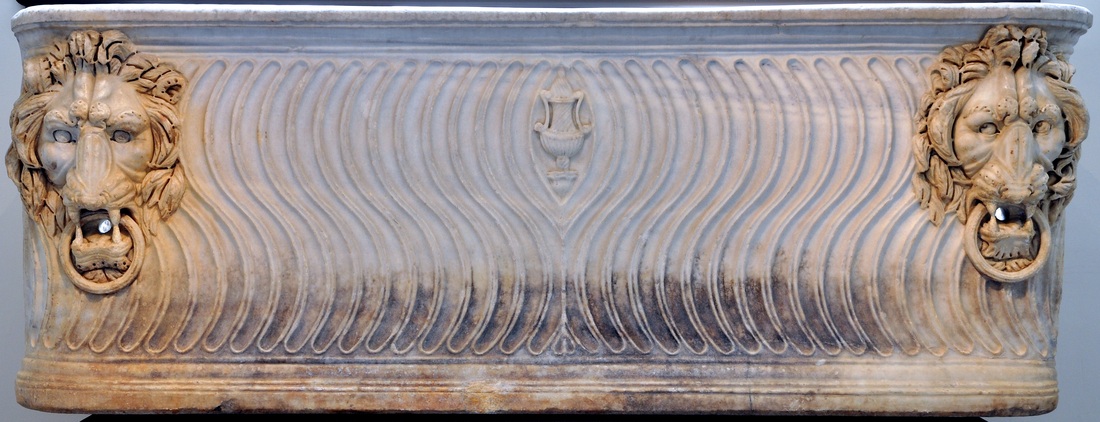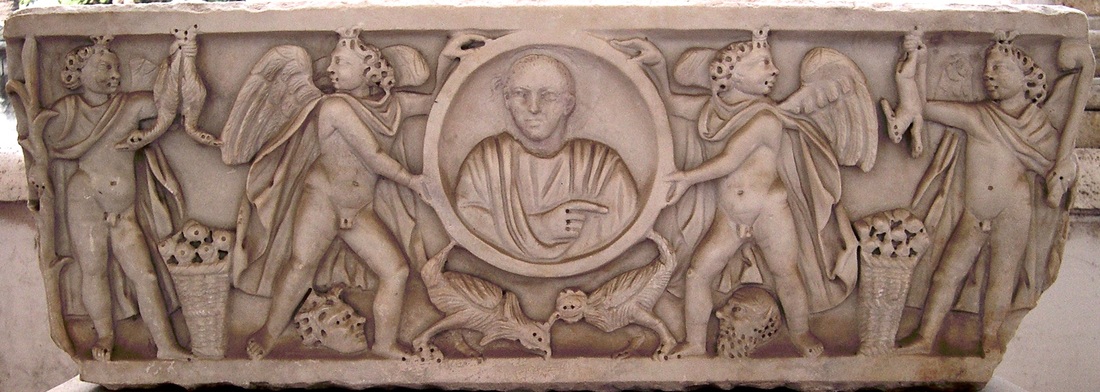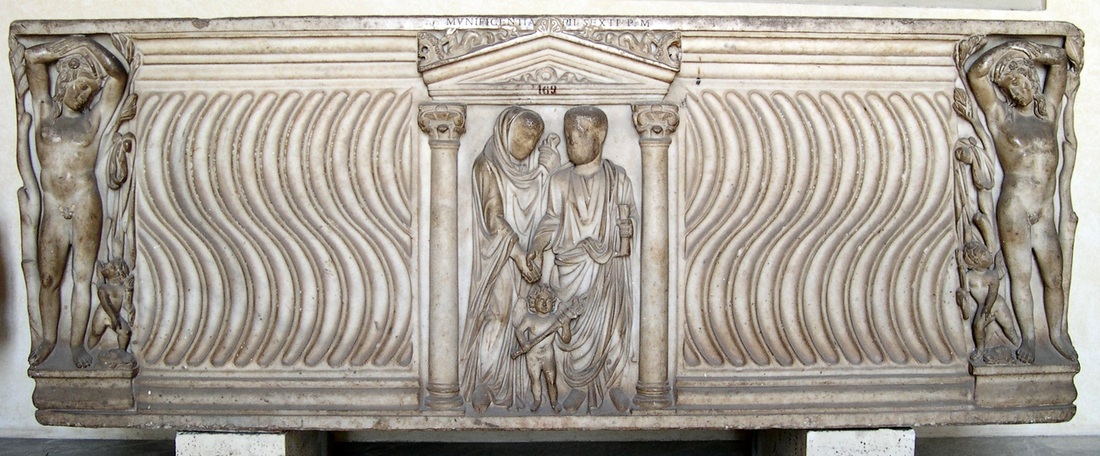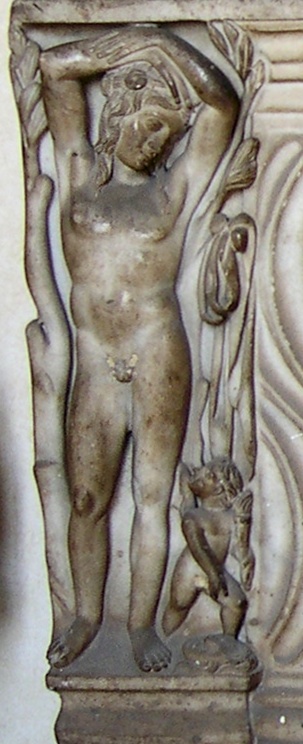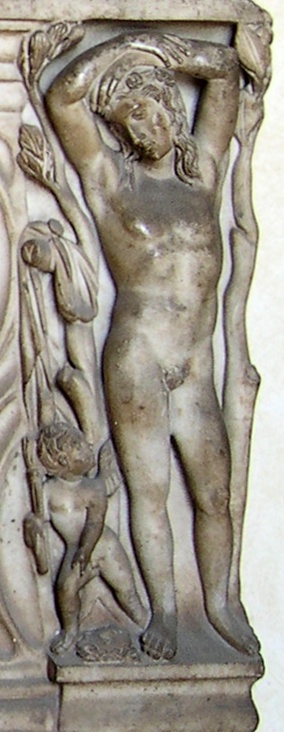|
The small dimensions of this piece reveal that it was intended for a child. Given the high rates of infant and juvenile mortality in the ancient world (as in most pre-industrial societies), it is perhaps no surprise that many Roman sarcophagi were carved for children. The sheer number of such pieces is, nonetheless, poignant. The portrait was clearly reworked in antiquity itself: originally intended to depict a young woman or girl, it was recarved to portray a (rather strikingly ugly) boy. That's not especially unusual: as we've already seen, recutting of portraits for reuse by other inhabitants was a common practice, and could even involve sex-changes along the way, as here. What is unusual here is our diminutive subject's off-the-shoulder drapery. It's so suggestive that one might wonder whether the original figure was meant to show Venus, or rather a woman in the guise of Venus. But while the occasional Roman matron was indeed portrayed in the costume and pose of the goddess — a form of mythological portraiture — such mythological portraiture, as far as I know, is never found inside the frame of a tondo/medallion (the Romans called it a clipeus, their word for 'shield', because of its round shape). When Romans equip themselves with the attributes of gods or heroes on sarcophagi, it's always as a full-body figure within a narrative frieze, not a bust isolated within a clipeus. But without the excuse of mythological trappings, what respectable Roman female would choose commemoration in such sexy garb? That it features on a child's sarcophagus makes things even more puzzling. On a different note... the motif of two fowl pecking the ground under the clipeus was clearly a stock vignette, as this piece shows. Comments warmly invited. (Both the Facebook system below, and the traditional comment form, work dandily.) Why does this sarcophagus have rounded ends? Why the lions' heads, and why are they chomping on rings? Because — and you'll probably think this kooky — this sarcophagus is carved in the shape of a wooden wine vat. The rounded ends are characteristic of the large tubs in which Romans pressed grapes to make wine. More importantly, so are the lions: we know from ancient depictions of actual Roman wine troughs that they often carried fancy felines' heads, carved in relief near the ends of the vat. These served as elaborate (and humorous) decoration for the spigots (!) installed in their mouths: wine flowed from the ferocious maws of lions — if you dared to put your hand directly between their jaws to open the tap. They met other functional needs as well. The metal rings used as handles for hoisting and dragging the vat had to be embedded in something; and ideally that something would project outward from the rest of the tub, to make carrying easier. These leonine bosses thus served as anchors for carrying handles ("Think you can handle a lion? Now you can!") as well as fanciful frames for spigots. Here the form of one of those elaborate wine tubs has been translated into stone, to hold very different contents. This was a popular format for sarcophagi: many elite Romans commissioned this style of coffin, particularly during the third century. Just imagine a wealthy businessman or an important Senator choosing a stone-imitation wine vat as his vessel for eternity. This would be unthinkable for us. But it was entirely unproblematic for Romans, who so often — unlike us — preferred to meet death with humor. As a side note.... you'll observe that the marble from which this sarcophagus was carved has several bands of darker color that run through the stone. There's a wide, very dark band near the bottom; and a set of lighter, blue-gray bands that run across the top. That's a characteristic feature of marble quarried on the island of Proconnesus (now Marmara), not too far from Istanbul, in modern-day Turkey. It was a popular choice of stone for Roman sarcophagi in the third century. You might think it an odd choice, given how far Proconnesus is from Rome. But transport by sea was far easier and faster than transport over land in antiquity. And the quarries on the island were close to the water — unlike the quarries of Italy. As a result, shipping marble all the way from Turkey to Rome was actually cheaper than using marble from Italy itself. Comments warmly invited. (Both the Facebook system below, and the traditional comment form, work dandily.) Why does this young man appear to be sprouting phantasmic locks of hair from above his left ear? It seems that he's shadowed by the ghostly ponytail of the coffin's previous owner. The portrait has clearly been recut, and the original must have showed a boy devoted to the goddess Isis: her young male followers proclaimed their devotion by shaving their heads, razoring off everything except a single long tuft of hair above the ear. (The hairstyle was modelled on that of the mythic child Harpocrates, son of Isis.) Sheer need must have driven the later family to choose this piece — with its prior owner's prominently protruding hairstyle — for reappropration and recutting. Why not choose one with a portrait of a non-devotee, whose hair would be much less troublesome to erase? Or else simply make better use of abrasives to take down the background plane around the head, fully scrubbing off any lingering halo? Clearly money — or time — was limited, and the family made do with the used piece they had at hand: a striking reminder of the exigencies of death, the high rates of infant mortality in the ancient world, and above all, the frequent recarving and reuse of sarcophagi in antiquity by Romans themselves. ADDENDUM I return to this piece in a later post: The Phantom Ponytail returns. Comments warmly invited. (Both the Facebook system below, and the traditional comment form, work dandily.) Who is that boy who stands languidly with arms atop his head, doing his best impression of a male pin-up on both ends of this sarcophagus? And why is there a cupid at his feet, pointing to what looks like a theater mask on the ground? If he weren't doubled up, you might think he was Dionysus, or even Apollo, given the youthful features and the erotic posturing. But since he's duplicated, he probably doesn't represent a deity: Roman carvers often duplicated generic figures, and sometimes even mythological mortals; but they usually refrained from doubling up a god. So who is he? The answer: Narcissus. He's very uncommon: out of roughly 15,000 surviving Roman sarcophagi, only 5 (!) show Narcissus. But this is he. The cupid — that wee godling of desire — who stands at his feet is pointing not to a theater mask, but to Narcissus's own reflection. Which Narcissus, of course, is admiring: the erotic nature of his pose reflects his response to his own image. The composition seems bizarre to us: doesn't the Narcissus of Ovid's story (Metamorphoses 3:402-436) bend over the pool, or rather, lie beside it, rather than stand erect over it? Indeed he does. But the formal parameters of this particular format of sarcophagus, which left a tall but narrow field for mythological depiction at each end, imposed its own restrictions. If Narcissus and his reflection — plus a symbolically helpful (though in Ovid's original narrative, entirely absent) cupid — were all to be shown within this constricted space, our self-asorbed hero would have to stand. Comments warmly invited. (Both the Facebook system below, and the traditional comment form, work dandily.) |
Roman
|

